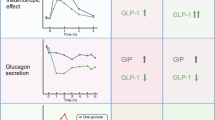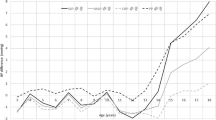Summary
Acromegaly is frequently associated with alterations of glucose metabolism but factors predisposing these patients to exhibit impaired glucose tolerance or overt diabetes at diagnosis are poorly understood. This study included 148 patients with newly diagnosed acromegaly (80 men; mean age: 45 ± 20 year). All patients underwent an oral glucose tolerance test (OGTT), unless already treated for diabetes. Insulin sensitivity (S) and β-cell function (B) were also evaluated by homeostasis model assessment (HOMA). Normal glucose tolerance (NGT) was observed in 67 patients (46 %), impaired fasting glycaemia (IFG) or glucose tolerance (IGT) were found in 39 (26 %), and diabetes mellitus (DM) in 42 (28 %). NGT patients were 10 years younger than patients with abnormal glucose metabolism (p < 0.001) and diabetic patients had a higher BMI (p < 0.05). While HOMA-S was similar, HOMA-B was reduced in the IFG/IGT group (p < 0.05) and further in the DM group (p < 0.001). IGF-I z-score was higher in IFG/IGT (5.2 ± 1.4) and DM patients (5.4 ± 1.3) than in NGT patients (4.4 ± 1.3; p < 0.05), but fasting and post-OGTT GH levels were not different between groups. In multivariate analyses, family history of diabetes and IGF-I were associated with hyperglycaemia, BMI and IGF-I predicted insulin resistance, and age was inversely correlated with β-cell function. Impaired glucose metabolism is present in more than 50 % of patients at diagnosis of acromegaly, and is associated with an older age, a higher BMI, a family history of diabetes and a higher IGF-I z-score, but not with fasting or post-OGTT GH levels.



Similar content being viewed by others
References
Melmed S (2009) Acromegaly pathogenesis and treatment. J Clin Invest 119:3189–3202
Melmed S, Casanueva FF, Klibanski A, Bronstein MD, Chanson P, Lamberts SW, Strasburger CJ, Wass JA, Giustina A (2012) A consensus on the diagnosis and treatment of acromegaly complications. Pituitary. doi:10.1007/s11102-012-0420-x
Colao A, Ferone D, Marzullo P, Lombardi G (2004) Systemic complications of acromegaly: epidemiology, pathogenesis, and management. Endocr Rev 25:102–152
Beauregard C, Truong U, Hardy J, Serri O (2003) Long-term outcome and mortality after transsphenoidal adenomectomy for acromegaly. Clin Endocrinol (Oxf) 58:86–91
Reid TJ, Post KD, Bruce JN, Nabi KM, Reyes-Vidal CM, Freda PU (2010) Features at diagnosis of 324 patients with acromegaly did not change from 1981 to 2006: acromegaly remains under-recognized and under-diagnosed. Clin Endocrinol (Oxf) 72:203–208
Fieffe S, Morange I, Petrossians P, Chanson P, Rohmer V, Cortet C, Borson-Chazot F, Brue T, Delemer B (2011) Diabetes in acromegaly, prevalence, risk factors, and evolution: data from the French Acromegaly Registry. Eur J Endocrinol 164:877–884
Arosio M, Reimondo G, Malchiodi E, Berchialla P, Borraccino A, De Marinis L, Pivonello R, Grottoli S, Losa M, Cannavo S, Minuto F, Montini M, Bondanelli M, De Menis E, Martini C, Angeletti G, Velardo A, Peri A, Faustini-Fustini M, Tita P, Pigliaru F, Borretta G, Scaroni C, Bazzoni N, Bianchi A, Appetecchia M, Cavagnini F, Lombardi G, Ghigo E, Beck-Peccoz P, Colao A, Terzolo M (2012) Predictors of morbidity and mortality in acromegaly: an Italian survey. Eur J Endocrinol 167:189–198
Kasayama S, Otsuki M, Takagi M, Saito H, Sumitani S, Kouhara H, Koga M, Saitoh Y, Ohnishi T, Arita N (2000) Impaired beta-cell function in the presence of reduced insulin sensitivity determines glucose tolerance status in acromegalic patients. Clin Endocrinol (Oxf) 52:549–555
Kreze A, Kreze-Spirova E, Mikulecky M (2001) Risk factors for glucose intolerance in active acromegaly. Braz J Med Biol Res 34:1429–1433
Stelmachowska-Banas M, Zdunowski P, Zgliczynski W (2009) Abnormalities in glucose homeostasis in acromegaly. Does the prevalence of glucose intolerance depend on the level of activity of the disease and the duration of the symptoms? Endokrynol Pol 60:20–24
Clemmons DR (2002) Roles of insulin-like growth factor-I and growth hormone in mediating insulin resistance in acromegaly. Pituitary 5:181–183
Moller N, Jorgensen JO (2009) Effects of growth hormone on glucose, lipid, and protein metabolism in human subjects. Endocr Rev 30:152–177
Puder JJ, Nilavar S, Post KD, Freda PU (2005) Relationship between disease-related morbidity and biochemical markers of activity in patients with acromegaly. J Clin Endocrinol Metab 90:1972–1978
Bex M, Abs R, T’sjoen G, Mockel J, Velkeniers B, Muermans K, Maiter D (2007) AcroBel–the Belgian registry on acromegaly: a survey of the ‘real-life’ outcome in 418 acromegalic subjects. Eur J Endocrinol 157:399–409
Standards of Medical Care in Diabetes (2011) American diabetes association. Classification and diagnosis of diabetes mellitus. Diabetes Care 34:S12–S13
Trainer PJ, Barth J, Sturgeon C, Wieringaon G (2006) Consensus statement on the standardisation of GH assays. Eur J Endocrinol 155:1–2
Brabant G, von zur Mühlen A, Wuster C, Ranke MB, Kratzsch J, Kiess W, Ketelslegers JM, Wilhelmsen L, Hulthen L, Saller B, Mattsson A, Wilde J, Schemer R, Kann P (2003) Serum insulin-like growth factor I reference values for an automated chemiluminescence immunoassay system: results from a multicenter study. Horm Res 60:53–60
Mekouar H, Gruson D, Maiter D, Maes M, Cumps J, Ketelslegers J (2009) Analytical and clinical evaluation of the automated Liaison Insulin-like growth factor-I (IGF-I) assay. Clin Chem 55:A188
Matthews DR, Hosker JP, Rudenski AS, Naylor BA, Treacher DF, Turner RC (1985) Homeostasis model assessment: insulin resistance and beta-cell function from fasting plasma glucose and insulin concentrations in man. Diabetologia 28:412–419
Dekkers OM, Biermasz NR, Pereira AM, Romijn JA, Vandenbroucke JP (2008) Mortality in acromegaly: a metaanalysis. J Clin Endocrinol Metab 93:61–67
Holdaway IM, Bolland MJ, Gamble GD (2008) A meta-analysis of the effect of lowering serum levels of GH and IGF-I on mortality in acromegaly. Eur J Endocrinol 159:89–95
Melmed S (2006) Medical progress: acromegaly. N Engl J Med 355:2558–2573
Bates AS, Van’t Hoff W, Jones JM, Clayton RN (1993) An audit of outcome of treatment in acromegaly. Q J Med 86:293–299
Bengtsson BA, Eden S, Ernest I, Oden A, Sjogren B (1988) Epidemiology and long-term survival in acromegaly. A study of 166 cases diagnosed between 1955 and 1984. Acta Med Scand 223:327–335
Orme SM, McNally RJ, Cartwright RA, Belchetz PE (1998) Mortality and cancer incidence in acromegaly: a retrospective cohort study. United Kingdom Acromegaly Study Group. J Clin Endocrinol Metab 83:2730–2734
Melmed S (2001) Acromegaly and cancer: not a problem? J Clin Endocrinol Metab 86:2929–2934
Ayuk J, Sheppard MC (2008) Does acromegaly enhance mortality? Rev Endocr Metab Disord 9:33–39
Sherlock M, Ayuk J, Tomlinson JW, Toogood AA, Aragon-Alonso A, Sheppard MC, Bates AS, Stewart PM (2010) Mortality in patients with pituitary disease. Endocr Rev 31:301–342
Tzanela M, Vassiliadi DA, Gavalas N, Szabo A, Margelou E, Valatsou A, Vassilopoulos C (2011) Glucose homeostasis in patients with acromegaly treated with surgery or somatostatin analogues. Clin Endocrinol (Oxf) 75:96–102
Moller N, Schmitz O, Joorgensen JO, Astrup J, Bak JF, Christensen SE, Alberti KG, Weeke J (1992) Basal- and insulin-stimulated substrate metabolism in patients with active acromegaly before and after adenomectomy. J Clin Endocrinol Metab 74:1012–1019
Kinoshita Y, Fujii H, Takeshita A, Taguchi M, Miyakawa M, Oyama K, Yamada S, Takeuchi Y (2011) Impaired glucose metabolism in Japanese patients with acromegaly is restored after successful pituitary surgery if pancreatic {beta}-cell function is preserved. Eur J Endocrinol 164:467–473
Steffin B, Gutt B, Bidlingmaier M, Dieterle C, Oltmann F, Schopohl J (2006) Effects of the long-acting somatostatin analogue Lanreotide Autogel on glucose tolerance and insulin resistance in acromegaly. Eur J Endocrinol 155:73–78
Mazziotti G, Floriani I, Bonadonna S, Torri V, Chanson P, Giustina A (2009) Effects of somatostatin analogs on glucose homeostasis: a metaanalysis of acromegaly studies. J Clin Endocrinol Metab 94:1500–1508
Yakar S, Liu JL, Fernandez AM, Wu Y, Schally AV, Frystyk J, Chernausek SD, Mejia W, Le Roith D (2001) Liver-specific igf-1 gene deletion leads to muscle insulin insensitivity. Diabetes 50:1110–1118
Kauppinen-Makelin R, Sane T, Reunanen A, Valimaki MJ, Niskanen L, Markkanen H, Loyttyniemi E, Ebeling T, Jaatinen P, Laine H, Nuutila P, Salmela P, Salmi J, Stenman UH, Viikari J, Voutilainen E (2005) A nationwide survey of mortality in acromegaly. J Clin Endocrinol Metab 90:4081–4086
Alexopoulou O, Bex M, Abs R, T’sjoen G, Velkeniers B, Maiter D (2008) Divergence between growth hormone and insulin-like growth factor-i concentrations in the follow-up of acromegaly. J Clin Endocrinol Metab 93:1324–1330
Espinosa-de-Los-Monteros AL, Gonzalez B, Vargas G, Sosa E, Mercado M (2011) Clinical and biochemical characteristics of acromegalic patients with different abnormalities in glucose metabolism. Pituitary 14:231–235
Niculescu D, Purice M, Coculescu M (2012) Insulin-like growth factor-I correlates more closely than growth hormone with insulin resistance and glucose intolerance in patients with acromegaly. Pituitary. doi:10.1007/s11102-012-0396-6
DeFronzo RA (1992) Pathogenesis of type 2 (non-insulin dependent) diabetes mellitus: a balanced overview. Diabetologia 35:389–397
Serri O, Beauregard C, Hardy J (2004) Long-term biochemical status and disease-related morbidity in 53 postoperative patients with acromegaly. J Clin Endocrinol Metab 89:658–661
Conflict of interest
The authors declare that they have no conflict of interest.
Author information
Authors and Affiliations
Corresponding author
Rights and permissions
About this article
Cite this article
Alexopoulou, O., Bex, M., Kamenicky, P. et al. Prevalence and risk factors of impaired glucose tolerance and diabetes mellitus at diagnosis of acromegaly: a study in 148 patients. Pituitary 17, 81–89 (2014). https://doi.org/10.1007/s11102-013-0471-7
Published:
Issue Date:
DOI: https://doi.org/10.1007/s11102-013-0471-7




